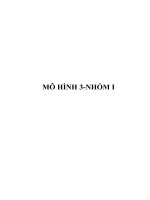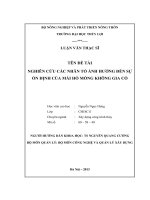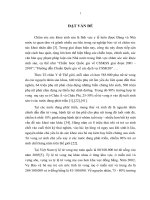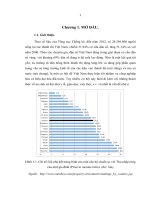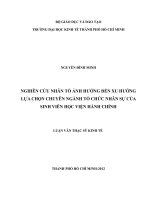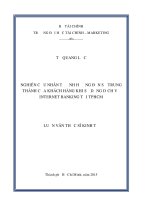NGHIÊN CỨU NHÂN TỐ ẢNH HƯỞNG ĐẾN SỰ HÀI LÒNG CỦA KHÁCH HÀNG SỬ DỤNG DỊCH VỤ KHÁCH SẠN TẠI THANH HÓA, VIỆT NAM
Bạn đang xem bản rút gọn của tài liệu. Xem và tải ngay bản đầy đủ của tài liệu tại đây (546.95 KB, 6 trang )
<span class='text_page_counter'>(1)</span><div class='page_container' data-page=1>
FACTORS AFFECTING CUSTOMER SATISFACTION IN HOTELS
AT THANH HOA PROVINCE, VIETNAM
Nguyen Thi Thanh Xuan*
Hong Duc University
SUMMARY
Although researches on the customers’ satisfaction in the world are abundant but in the field of
hotel industry in Thanh Hoa is very little. This is the first official study in Thanh Hoa on the
influence of factors on customer satisfaction in hotel services at Thanh Hoa. Through a 380
respondents of the survey, the test results show that Tangible and Intangible elements of Service
Quality, Perceived value, Brand image, Customer Relationship Management have a positive
impact on Satisfaction. Of which, intangible is the element that has the strongest influence on
customer satisfaction, followed by Tangible elements, Brand image, Perceived Value, and finally
Customer Relationship Management. In addition, foreigners, over 7-day-staying duration and
higher education customers tend to be more satisfied than other groups, which help to suggest
important and appropriate solutions for hotels in Thanh Hoa province.
Key words: factors; customer; satisfaction; hotels; Thanh Hoa; service.
INTRODUCTION *
Thanh Hoa is the province that have full of
potentials for developing tourism industry,
bringing the good revenue for local economic
development and improve the citizens’ living
conditions. In the period 2011-2015, the
province has welcomed over 21 million
visitors, the average growth rate of over 13%
per year, up from the national average (8.6%
per year). Total revenue from tourists is
estimated at VND 16,715 billion, a growth
rate of 27.4% per year. In 2016, Thanh Hoa
received 6,250,000 visitors with total tourism
revenue reaching 6,250 billion VND. By
2020, it will receive over 11,200,000 visitors
[1]. In term of accomodation service, by
2016, Thanh Hoa province has nearly 700
establishments with 20,000 rooms, ranked
number 6 in the country, of which 154 hotels
were starred and 419 establishments met
national requirements [2]. This opens up the
opportunity for businesses in the field of
tourism to approach exploitation in the future.
The issue for the Thanh Hoa tourism,
especially the hotel business, is how to satisfy
existing customers and attract future
customers to maintain this positive growth.
The fact that providing good services quality
*<sub>Tel: 0946254888; Email: </sub>
not only gives enterprises a special
competitiveness, but also enhances the
position and image in the market and
occupies customer satisfaction in the situation
that keeping an old customer costs five times
less than finding new customers in the current
fierce competition [3], [4]. Meanwhile,
satisfaction is one of the most important
factors for attraction of customers [5]. With a
preliminary view on characteristics,
limitations of hotels, and the lack of related
studies in Thanh Hoa, the research “Factors
affecting customer satisfaction in hotels at
Thanh Hoa province, Vietnam" was aimed at
finding out factors that had affect to
satisfaction in thirteen 3 to 5 – star hotels at
Thanh Hoa, the level of impacts and
proposing appropriate solutions for the
improvement of customers’ satisfaction.
Customer satisfaction and influence factors
Customer satisfaction is the evaluation after
using of the service [6]. It is an effective
attribute of emotional response through which
customers know their needs and expectations.
Customer satisfaction plays an important role
because it affects the long-term growth of
profitability [7].
</div>
<span class='text_page_counter'>(2)</span><div class='page_container' data-page=2>
hospitality is the most influential factor in
determing satisfaction for both Asian and
Western tourists. Asian travellers are more
interested in value, while Western travellers
concerned more about security and safety [8].
A research of relationship between Hotel
Ratings, Service Quality, Customer
Satisfaction and Loyalty at Ethiopian Hotels
concluded that there are significant
relationships between these concepts [9].
Customer satisfaction depends not only on the
ratings of hotels but also rely heavily on the
quality of hotel services, which providing
positive value perception to customers
[10],[11]. A study in Egypt concluded that
customer satisfaction depended tourism
services, levels of customer satisfaction to the
hotel’s services, value related to services’
prices, accommodations, internal
transportation, and suitable prices [12]. Other
study agreed on the point that service quality
and service features played an important role
in augmenting satisfaction [13]. In Vietnam,
empathy and assurance, tangibility and hotel
image directly affected customers’
satisfaction [14]. Data collected from 432
guests of 33 three-star hotels in Vietnam in
2013 indicate that factors of Service Quality
(Reliability, Responsiveness, Assurance, and
Empathy) significantly impact on the
customer satisfaction [15]. Nham (2014)
comfirmed this relationship on 5 star hotels
using SERVPERF model as a conceptual
framework [16].
Research Model
The relationship between factors as perceived
quality, perceived value, brand image,
customer relationship management with
customer satisfaction is very complex [17].
However, this study has considered the
relationship between five independent factors
(on the left side) and customer satisfaction
factor (dependent factor on the right side).
The research also proposed the impact of
some demographic characteristics such as
gender, nationality, income, age, education
level and duration to the satisfaction of
customers using hotels in Thanh Hoa
province (Figure 1).
RESEARCH METHOD
The research used both quantitative and
qualitative methods. Qualitative data was
collected from secondary sources of hotels
and departments. For quantitative data, the
model identified 29 variables, so, the sample
size must be at least 29 * 5 = 145 [18]. In this
study, the author surveyed 25 clients of each
13 hotels from 3-5 stars, so the number of
sample according to experiential method
should be 325. Excluding ineligible answers,
the researcher decided to choose the number
of the questionnaire is 400. The researcher
used quota sampling technique to divide
questionnaires for 13 hotels, and then
continued to use the convenient sampling
method to select the customers [19]. Three
hundred and eighty valid respondents have
met the criteria: (1) over 18 years old; (2)
have used the services in the last 6 months.
The survey was done in two forms: direct
questionnaires and e-mail surveys. Statistical
analysis tool was SPSS 20.
Figure 1. Research model
Gender, Nationality, Age,
Monthly income,
Educational level,
Duration
Perceived Quality
Perceived Value
CRM
Brand image
Customer
satisfaction
Tangible elements
</div>
<span class='text_page_counter'>(3)</span><div class='page_container' data-page=3>
RESULTS AND DISCUSSTION
Respondents of the study
Respondents Total In % Respondents Total In % Respondents Total In %
Gender
Male 243 63.9
Hotel
name
Lam Kinh 54 14.2
Purpose
Job related 153 40.3
Female 137 36.1 Thien Y 47 12.4 Entertain 227 59.7
Total 380 100 M. Thanh 51 13.4 Total 380 100
National
-ity
Vietnamese 251 66.0 Anh Phat 2 20 5.3
Type of
hotel
3 stars 151 39.7
Foreigner 129 34.0 Sao Mai 25 6.6 4 stars 204 53.7
Total 380 100 Phu Dong 26 6.8 5 stars 25 6.6
Educa-tion
level
Post graduate 57 15.0 Phonenix 20 5.3 Total 380 100
Bachelor 198 52.1 Bien Nho 20 5.3
Infor-mation
channel
Relative 126 33.2
Lower 125 32.9 VDB 20 5.3 Website 114 30.0
Total 380 100 Van Chai 21 5.5 Business 41 10.8
Occu-pation
Employed 180 47.4 Viet Hung 20 5.3 Telephone 23 6.0
Self-employed 106 27.9 DragonSea 31 8.1 Brochure 38 10.0
Unemployed 39 10.3 FLC SS 25 6.6 Different 38 10.0
Students 49 12.9 Total 380 100 Total 380 100
Different 6 1.6
Durat-ion
1 night 104 27.4
Service
Forms
Entire of
service 195 51.3
Total 380 100 2-4 nights 118 31.1
Monthly
income
< 5 mil VND 38 10.0 5-7 nights 50 13.2
Part of
service 185 48.7
5-10 mil VND 153 40.3
>7 nights 108 28.4
>10 mil VND 189 49.7
Total 380 100 Total 380 100 Total 380 100
Findings
Description Analysis
The results show that customer item ratings are in the range of Fair to Good. The highest average
value is the hotels’ tangible element (3.53) and the lowest values are Intangible elements (3.37).
About the tangible facilities, customers appreciate the availability and the full range of
equipments and additional services, due to the reason that the hotels from 3 to 5 stars in Thanh
Hoa province are almost new, which were built in the last five years. In term of Intangible
elements and Brand Image, customers only evaluated these factors at the medium level. In
general, customers are fairly satisfied with the services of 3-5 star hotels in Thanh Hoa.
Reliability of the scale
Table 1 shows the test reliability of the scale after EFA step. The result shows that the scales both
have a reasonalble strong Cronbach's Alpha coefficient. The Corrected item - Total correlation of
items are all more than 0.3.
Table 1. Results of Cronbach's alpha testing
Code Items C. Alpha if Item
Deleted C. Alpha of group
INTAG1 Hotel staffs are well knowledgeable about services .862
.87
INTAG2 The assurance of safety is made by hotels’ staffs .837
INTAG3 The staffs of the hotel gives the customer confidence .847
INTAG4 The staff of the hotel is very enthusiastic and friendly .825
INTAG5 The hotel has provided the right service as promised .842
INTAG6 Customers are always fully provided with information .869
TAG1 The hotel has full of facilities for clients .829
.841
TAG2 Availability of added services .778
TAG3 The good physical features of the hotel .800
TAG4 The hotel have modern equipments .796
TAG5 The attractiveness of the lobby area .839
</div>
<span class='text_page_counter'>(4)</span><div class='page_container' data-page=4>
Code Items C. Alpha if Item
Deleted
C. Alpha of
group
CRM2 Hotel provides service in line with customer’s demand
and personalization .724
CRM3 Hotel has small souvenir for guests .777
CRM4 Good customer information security system .803
CRM5 Hotel staff always call to inquire about the satisfaction .785
VALUE1 Price corresponds to the quality of service .665
.771
VALUE2 Hotel services prices are competitive .653
VALUE3 The prices of hotel services are diversified .755
BRA1 The brand of the hotel impresses customers .599
.689
BRA2 The hotel brand is easily recognizable .530
BRA3 I easily imagine its characteristics .652
SATIS1 I am completely satisfied with the services .824
.839
SATIS2 Hotel services meets my expectations .811
SATIS3 I feel very happy to use the hotel services .795
SATIS4 I will recommend to acquaintances .803
SATIS5 I have positive statements about the hotel .793
SATIS6 Hotel is the first choice I think of .828
SATIS7 I will continue to use the hotel's services in the future .821
Exploratory Factor Analysis - EFA
The study conducted the EFA for 22 items of 5 factors. The results showed that KMO = .824;
Bartlett's Test = 3392.354 with Sig =0.00 < 0.05, it means that the application of EFA in the study
is appropriate. Moreover, factors have the Eigenvalue >1, which explains greater than 50%
(62.096%) of the variables, the observed variables are grouped exactly as the initial scale (Table 2).
Table 2. Rotated Matrix of factors
Factor
1 2 3 4 5
INTAG4 .853
INTAG2 .789
INTAG5 .743
INTAG3 .700
INTAG1 .604
INTAG6 .567
TAG2 .845
TAG4 .734
TAG3 .723
TAG1 .570
TAG5 .563
CRM2 .854
CRM1 .796
CRM3 .583
CRM5 .556
CRM4 .519
VALUE2 .777
VALUE1 .735
VALUE3 .609
BRA2 .769
BRA1 .565
BRA3 .527
Table 3. Verification of the fit of the model
Model Summaryb
Model R R Square Adjusted R Square Std. Error of the Estimate Durbin-Watson
</div>
<span class='text_page_counter'>(5)</span><div class='page_container' data-page=5>
Regression analysis
According to the results of the correlation,
independent variables are correlated with the
dependent variable. To assess the impact of
each factor on the customer satisfaction at the
hotel, the author uses a multivariable
regression model. After running SPSS 20
software, the result is as Table 3.
Test F shows the significance level (Sig. =
0.000) and R Square = 0.522 (Adjusted R
Square = 0.515) demonstrates the suitability
of the model, which is more than 50% of
service satisfaction was explained by 5
independent variables. The Durbin-Watson
coefficient = 1.713 (> 1) indicates that there is
no autocorrelation between variables. The
results of multiple regression analysis showed
the importance of each factor, which was
depended on the standardized Beta. The
impact level of each factor are as order:
Intangible (ᵦ = 0.271); Tangible (ᵦ = 0.259);
Brand image (ᵦ = 0.251); Perceived value (ᵦ =
0.193); Customer Relationship Management
(ᵦ = 0.169). The differences in term of
demographic variables after testing T-test and
Anova also revealed that foreigners, higher
education customers and over 7 day-staying
customers tend to be more satisfied to the
hotels than the others, which may suggest
important and appropriate solutions for hotels
in Thanh Hoa province for this market share.
Discussion
In the Thanh Hoa province market, according
to the results, satisfaction of customers to the
hotels’ brand is fair. This can be explained by
the fact that hotels mostly have been newly
built in recent years so they have not had
strong brand image enough. Because of the
new operation, the facilities and equipment of
the hotels now are very new and modern.
However, in the future time, hotels must have
more strategy to upgrate and replace old
facilities and equipments because technology
must be updated time by time. In terms of
human resource quality, it can be found that
the number of unskilled staffs is high,
especially in some hotels, where unskilled
workers account for one-third or even a half of
the workforce. This is a great challenge for
tourism businesses in particular and hotel
business in Thanh Hoa province in general.
The results of this study are consistent with
previous research findings in the service
sector, particularly hotel services: tangible and
intangible elements of service quality [20],
value [21], brand image [22], customer
relations are mutually connected [23]. At the
same time, service quality is the most
important factor influencing customers’
satisfaction.
CONCLUSION, LIMITATION AND IMPLICATION
By a survey of 380 customers in Thanh Hoa,
the research has demonstrated the influence of
Tangible, Intangible elements, Perceived
Value, Brand Image and Customer
Relationship Management to Customer
Satisfaction, of which Service Quality has the
most impact. In addition, the study found that
foreign customers and high education level
customers tend to be more satisfied to the
hotels than the other, which may suggest
important and appropriate solutions for hotels
in Thanh Hoa province for this market share.
Based on the research results, in order to
improve customer satisfaction, 3 to 5-star
hotels in Thanh Hoa province should focus on
improving service quality as it is the strongest
factor impact on customer’s adjustment. The
other important factor to focus on is the
improvement of human resource factor
through the provision of short-term and
long-term training programs, the process of
recruiting, using and educating hotel staffs so
that they can provide customers with the most
complete, timely and accurate information on
the services provided by hotels. In addition,
hotel businesses need to set competitive and
diversified prices to the needs of customers;
improve brand image through promotion
strategy, diversification and differentiation
strategy to connect with new customers
through an effective CRM strategy.
</div>
<span class='text_page_counter'>(6)</span><div class='page_container' data-page=6>
REFERENCES
1. Thanh Hoa People's Committee (2015), “Approving the
Thanh Hoa tourism development strategy up to 2025, with
vision to 2030”, Decision No. 492/ QD-UBND dated 9/2/2015
of the Chairman of Thanh Hoa People's Committee.
2. 08/13/2016
3. Barsky, J. (1994), World-class customer satisfaction,
Burr Ridge, IL: Irwin.
4. Reichheld, F.F. and Sasser, E. (1990), “Zero
Defections: Quality Comes to Services”, Harvard Business
Review, Vol 68, pp. 105-111.
5. Samaan Al-Msallam and Abdullah Alhaddad (2016),
“Customer Satisfaction and Loyalty in the Hotel Industry:
the Mediating Role of Relationship Marketing (PLS
Approach)”, Journal of Research in Business and
Management, Volume 4 (5), pp. 32-42.
6. Hunt, K. H (1977), “Customers Satisfaction
/Dissatisfaction- Overview and Future Directions, in Hunt,
K. H. Conceptualization and Measurement of Customer
Satisfaction and Dissatisfaction”, Marketing Science
Institute, Cambridge, MA, pp.71-109.
7. Ribbink, D. Riel, A. C. R. V., Liljander, V. and
Streukens, S. (2004), “Comfort your online customer:
quality, trust and loyalty on the internet”. Managing
Service Quality, Vol 14, (6); pp. 446-644.
8. Wai Ching Poon and Kevin Lock Teng Low (2005),
“Are travellers satisfied with Malaysian hotels?”
International Journal of Contemporary Hospitality
Management, Vol 17 (3), pp. 217-227.
9. Orthodox (2014), “Hotel ratings, service quality,
customer satisfaction and loyalty: The perception of guests
at Ethiopian Hotels”, African journal of hospitality, tourism
and leisure, special edition, Vol 5 (3), 2016, pp. 1-18
10. Hou Xingqi (2008), The Study on Service Quality
Customer Satisfaction and Loyalty, Shandong University.
11. Kofi (2013), “Impact of Service Quality on Customer
Loyalty in the Hotel Industry: An Empirical Study from
Ghana”, International review of management and business
research, Vol 2 (2), pp. 600-609.
12. Eraqi MI (2006), “Tourism services quality in Egypt: The
viewpoints of external and internal customers Benchmarking”,
An International Journal, Vol 13(4), pp. 469–492.
13. Aamna Shakeel Abbasi (2010), “Determinants of
Customer Satisfaction in Hotel Industry of Pakistan”,
European Journal of Scientific Research ISSN 1450-216X,
Vol.48 (1), pp.97-105.
14. Mai Ngoc Khuong, Pham Le Hoang Ngan and Nguyen
Thi Minh Phuong (2015), “Factors of affecting guests’
satisfaction and their loyalty – A study of Luxury hotels in Ho
Chi Minh City, Vietnam”, International Journal of Innovation,
Management and Technology, Vol 6 (3), pp. 186-190.
15. Nguyen Hue Minh, Nguyen Thu Ha, Phan Chi Anh &
Yoshiki Matsui (2013), “Service Quality and Customer
Satisfaction: A Case Study of Hotel Industry in Vietnam”, Asian
Social Science; Vol. 11 (10); ISSN 1911-2017, Published by
Canadian Center of Science and Education, pp. 73-85.
16. Nham Phong Tuan and Nguyen Thi Hai Linh (2014),
“Impact of service quality performance on customer
satisfaction: A case study of Vietnam’s 5 star hotels”,
ABAC Journal, Vol. 34 (3), pp.53-70
17. Huy Le Van, My Nguyen Thi Ha (2008), “Develop a
theoretical model and measurement method for the
Customer Satisfaction Index in Vietnam”, Da Nang Science
and Technology Journal, pp. 92-95.
18. Hair J., Anderson R., Tatham R., Black W., 1998,
Multivariate Data Analysis, 5th edition, Prentice Hall
International, London.
19. Dinh Phi Ho (2013), Economic Research Methodology
and master thesis writing, Economic Publishing House, Ho
Chi Minh City.
20. Liang (2008), “The determining factors of customer
loyalty for Luxury hotels in US”, The Journal of International
Management Studies, Volume 3 (2), pp. 167-175.
21. Binh Le (2017), “The impact of the quality of tourism
services, the price perception to satisfaction and loyalty of
visitors to destinations in Thanh Hoa province”, Journal of
Economics and Development, Vol 242 (II), pp. 91-101.
22. Taylor, Kevin Celuch, Stephen Goodwin (2004), “The
importance of brand equity to customer loyalty”, Journal of
Product & Brand Management, Vol. 13 (4), pp.217-227.
23. Mostafa (2005), "An empirical study of patients'
expectations and satisfactions in Egyptian hospitals",
International Journal of Health Care Quality Assurance,
Vol. 18(7), pp.516-532.
TÓM TẮT
NGHIÊN CỨU NHÂN TỐ ẢNH HƯỞNG ĐẾN SỰ HÀI LÒNG CỦA KHÁCH HÀNG
SỬ DỤNG DỊCH VỤ KHÁCH SẠN TẠI THANH HÓA, VIỆT NAM
Nguyễn Thị Thanh Xuân*
Trường Đại học Hồng Đức
Mặc dù các nghiên cứu về sự hài lòng của khách hàng trên thế giới rất phong phú nhưng trong lĩnh vực khách
sạn ở Thanh Hóa rất ít. Đây là nghiên cứu chính thức đầu tiên ở Thanh Hoá về ảnh hưởng của các yếu tố đến
sự hài lòng của khách hàng đối với các dịch vụ khách sạn ở Thanh Hóa. Thơng qua 380 khách hàng tham gia
cuộc khảo sát, kết quả kiểm định cho thấy các yếu tố vơ hình và hữu hình của chất lượng dịch vụ, giá trị cảm
nhận, hình ảnh thương hiệu, quản lý quan hệ khách hàng đều có tác động tích cực đến sự hài lịng của khách
hàng. Trong đó, yếu tố chất lượng vơ hình là yếu tố có ảnh hưởng mạnh nhất đến sự hài lịng của khách hàng,
theo đó là các yếu tố hữu hình, hình ảnh thương hiệu, giá trị cảm nhận và cuối cùng là quản lý quan hệ khách
hàng. Ngoài ra, nghiên cứu cho thấy khách hàng nước ngoài, khách hàng lưu trú trên 7 ngày và khách hàng có
trình độ giáo dục đại học có xu hướng hài lòng với các dịch vụ khách sạn hơn so với các nhóm khác, giúp đưa
ra các giải pháp quan trọng và thích hợp cho các khách sạn ở tỉnh Thanh Hố.
Từ khóa: Nhân tố; sự hài lòng; khách hàng; dịch vụ; khách sạn; Thanh Hóa.
Ngày nhận bài: 06/4/2018; Ngày phản biện: 03/5/2018; Ngày duyệt đăng: 29/6/2018
</div>
<!--links-->
